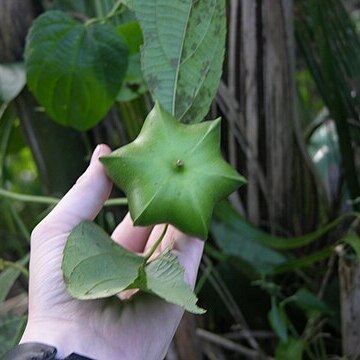Liana; twigs minutely appressed-pubescent, glabrescent. Leaves membranous; petioles mostly 3-8 cm long; stipules brownish, glabrous, ovate-lanceolate, 1-1.5 mm long; blades ovate, ca 7-13 cm long, 5-12 cm broad, glabrate and shining above, glabrate or sparsely hirsutulous and paler beneath, ventrally with 2 promi-nent ellipsoidal shining marginal glands (ca 1.5-2 mm long) near the base, major veins at base of blade 3, the remainder of blade pinnately veined (3 or 4 major laterals on either side), the veinlet reticulum conspicuous, the base truncate to subcordate, the margins finely to rather coarsely denticulate, the apex abruptly caudate-acuminate. Inflorescences axillary, , ca 3-8 cm long at anthesis, becom-ing up to 15-20 cm long in fruit; y flowers solitary at lowermost nodes, c3 flowers in clusters at distal nodes. Staminate flowers with pedicels ca 1-1.5 mm long; calyx-segments generally 4, lanceolate, acute, 1.8-2.5 mm long; receptacle conical, 0.7-1.5 mm high; disc obsolete; stamens 19-24, inserted spirally on the receptacle, the filaments 0.3-0.6 mm long, the anther-sacs bipartite, the locules discrete (hence anthers 4-partite), 0.3-0.4 mm long, the connective apex blunt and glandular. Pistillate flowers with pedicels becoming 10-15 mm long; calyx-lobes oblong-lanceolate, 1.8-2 mm long, 0.9-1 mm broad; ovary of 4 glabrous carinate carpels, the stylar column 11-25 mm long, slender, the stigmas thick, bilobed. Capsules deeply 4-lobed, oblate, up to ca 2 cm high, 3.5 cm broad, the cocci thick and rigid; seeds lenticular with thinner margins, reticulate-venose, brownish-mottled, 15-17 mm broad.
More
A vine. It grows 8 m long. The leaves are alternate and simple. They are 8-12 cm long by 5-8 cm wide. They are oval and taper to the tip. The flowering stalks are 5-10 cm long. The male flowers are greenish-yellow and 2-3 mm across. The fruit is a capsule 4-5 cm across. It is green and sharply four angled and with wings.

